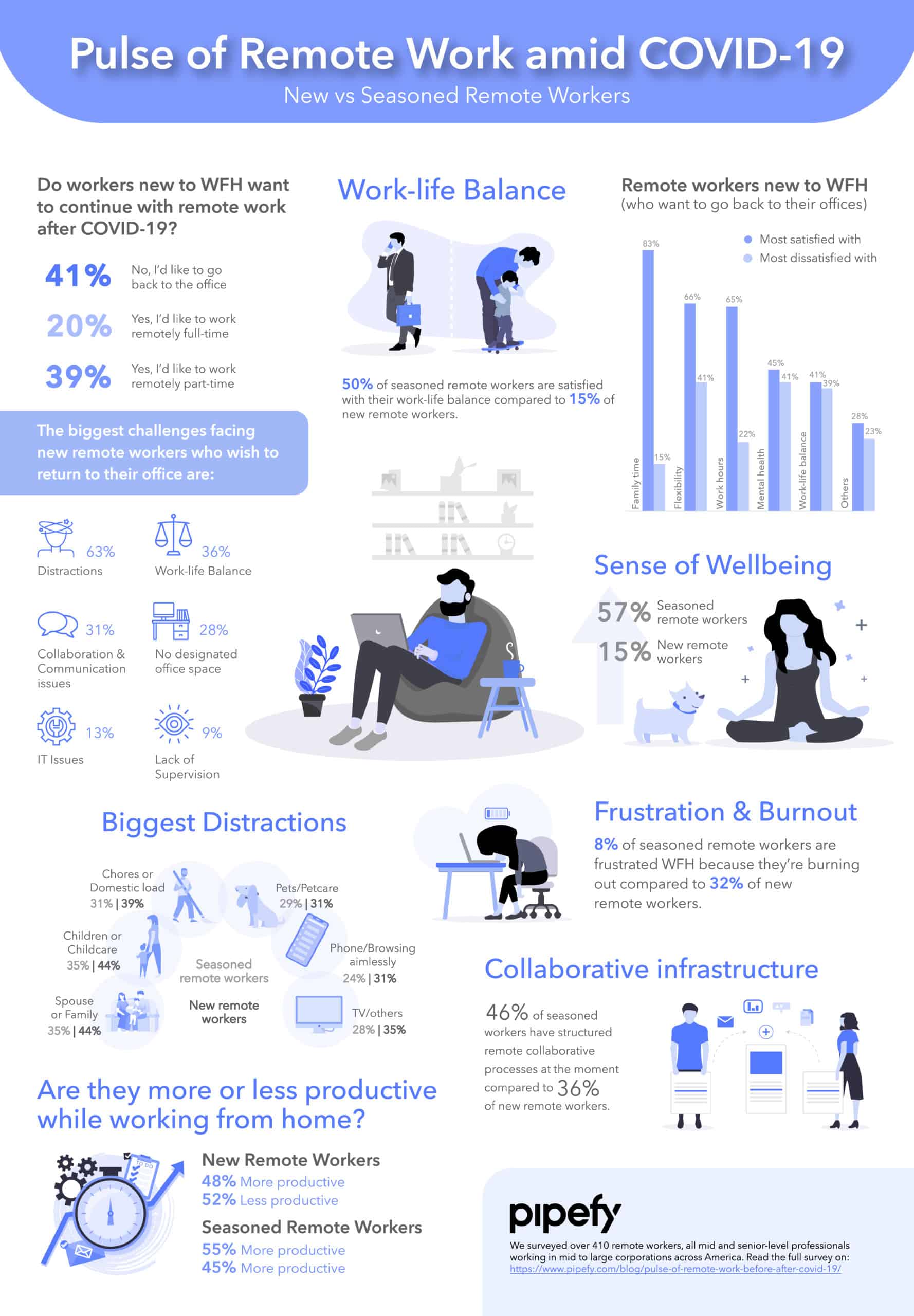
The COVID-19 pandemic has presented two significant situations: the rapid and large-scale transition to remote working and an opportunity to imagine work differently.
Due to the global lockdown and restrictions on movement, employees of large and small organizations are now operating remotely. It looks like the work-from-home model may be here to stay for a significant section of the workforce.
With an eye on the future, we conducted a survey — Pulse of Remote Work: Before & After COVID-19 — among 410 respondents, all mid- and senior-level professionals working in mid- to large corporations across America.
Of our respondents, 66 percent of workers were working remotely for the first time, that is, after the recent lockdown due to the COVID-19 pandemic. Whereas 14 percent were part-time remote workers before the lockdown and only 20 percent were full-time remote workers even before the lockdown.
We use the data from this diverse demographic to identify the problems new remote workers face in settling into this “new normal” in comparison to seasoned remote workers. We get inside the mindsets of employees making this shift to understand how people feel about working remotely, what works and what needs to change.
Our survey findings depart from the rosy picture painted by Buffer’s 2020 State of Remote Work Report. Their survey covered remote workers which did not include the population that was working in traditional offices prior to the COVID-19 pandemic and have only now transitioned into remote work. The concerns faced by these new remote workers have now been addressed in our survey.
Key Takeaways
There’s a significant gap between seasoned remote workers and new remote workers today. It appears that new remote workers may have a few things to learn from full-time seasoned remote workers.
Below are some of the findings from the survey that instantly stood out to us.
The first thing that drew our attention was that 41 percent of new remote workers would like to go back to working from the office after the lockdown. Whereas, only 20 percent of the new remote workers would like to work remotely full-time.
See Chart #1 below.

So, we dug deeper to find out more about this segment of new remote workers. In doing so, we found out that only a minority of this population (15 percent) are satisfied with their work-life balance, whereas, almost 50 percent of full-time remote workers are satisfied with their work-life balance.
See Chart #2 below.

A look at the biggest challenges faced by new remote workers instantly showed that this new segment struggles with distractions. Over 60 percent of respondents claim distractions to be the biggest challenge. Maintaining a work-life balance comes in a distant second.
See Chart #3 below.

We also wanted to understand their satisfaction levels across other areas. So we asked them what they were most satisfied and dissatisfied about. It is interesting to note that they were most satisfied with family time, flexibility, and work hours, while they were most dissatisfied with their mental health and work-life balance.
See Charts #4 and #5 below.


A quick look at the following 2 charts should highlight the marked difference between new remote workers and seasoned remote workers. See Charts #6 and #7 below.
Only 15 percent of new remote workers feel a greater sense of well being working from home. In contrast, seasoned remote workers seem to have cracked the well-being from home code. A significant number (57 percent) of them reported a greater sense of well being while working from home.


The only crucial question that remains is whether mental stress comes from enforced isolation due to the lockdown or if remote working itself is the problem. Further survey questions help us to understand this.
Other survey findings
The importance of Communication and Collaboration

The dual aspects of communication and collaboration become essential for productivity and efficiency. This requires a clear idea of one’s daily work, the order of priority of work and proper communication tools and remote collaborative processes in place to participate in team meetings and successfully execute work.
The survey found that a vast majority (54 percent) of the respondents do not have a structured collaborative infrastructure in place. They stated that they either used emails, messages, calls, or platforms like Google Docs to communicate and align with their team.
Surprisingly, only 33 percent of respondents stated that they had the necessary remote collaboration tools to ensure the entire team is aligned on the process.
Additionally, 14 percent of the remote workers stated that they currently don’t have a process for collaboration. See Chart #8 below.

Additionally, we asked them about the clarity they had on their day to day responsibilities, and only 41% of all remote workers stated that they had full clarity on their priorities and responsibilities. This tells us that communication tools and technology need to be improved for effective collaboration between teams.
We broke this data down by seasoned vs. new remote workers, and once again the difference is only marginal. Although, the only difference that stood out to us is that there were no respondents among full-time remote workers who had zero clarity on their priorities.
See Charts #9 & #10 below.


Lastly, only 39 percent of all remote workers had visibility on their team’s contribution and knew exactly what their team was doing. Whereas, the majority of the remaining respondents knew how their colleagues were contributing through casual communication.
See Chart #11 below.

It is important for employers to provide systems and opportunities that allow the workers visibility on their colleagues’ contributions for a project in order to avoid resentment and disproportionate work distribution.
Additionally, only 46 percent of all respondents stated that their organization has established work from home policies in place.
Lack of infrastructure in their work-from-home setups

In the survey, 49 percent of all remote workers stated that they did not have the right equipment and materials required to work from home. This seems to be a common bottleneck among both groups.
See Chart #12 below.

This means that only a few employers have become adept at providing the necessary technology, infrastructural tools and material to clear possible bottlenecks in working from home.
A large number of both seasoned and new remote workers need their employers to resolve these impediments to remote working. Employers need to ensure the availability of such material in order to initiate a smoother remote experience for the employees, which in turn will increase workers’ output and levels of work satisfaction.
When working from home, what do you miss the most?

Working from home excludes the possibility of spontaneous interactions that are so common to maintaining an informal office culture where crucial information is exchanged, steam is let off and office gossip traded.
We found that the majority of all remote workers miss casual conversations and spontaneous work-related conversations during lunch, smoke breaks, or the elevator with colleagues.
A small percentage of them miss the social life at office like birthday celebrations, fun activities at work; a few miss the chance to get away from their family, and an even smaller percentage who miss office snacks, gym, conference rooms, etc. Chart #13 below, indicates that even seasoned workers feel the pangs of seclusion, despite being more used to remote working.

The data above shows the importance of having a thriving virtual office culture to maintain the happiness quotient of employees and reduce feelings of isolation, especially during the lockdown. So, we asked all our respondents if they had any established virtual interactive sessions in place (Activities like dine digitally, virtual happy hours or coffee, workout sessions, games, birthday celebrations etc). We saw a slightly higher rate with seasoned remote workers in comparison to new remote workers which indicates that they may have adapted to a remote work set-up prior to COVID-19.
See chart #14 below.

Employers must initiate an environment that allows employees to interact with each other on informal terms, with activities like digital dining, virtual birthday celebrations and happy hours, joint workout sessions, team-building exercises through virtual games and other such bonding platforms. This will significantly boost employee morale and contribute to more productivity. After all, a happy worker is a good worker!
Conclusion

There has been a sudden and sometimes uneasy transition to remote working after the lockdown. While it has its benefits like no commute time, more family time, more flexibility and control over work hours, it also poses its own problems. For new workers, distractions regarding family, chores, TV, pets and not having designated office space at home become key challenges to navigate. This also has an impact on their mental welfare which can affect both their well-being and productivity over time.
Seasoned full-time remote workers are better off on some counts like dealing with distractions, having more time to acclimatize to the challenges presented by working from home. However, they often face the same challenges that new remote workers do. It is about how these challenges are tackled.
The survey established that there were other significant factors that were challenges to remote working for both new and seasoned remote workers. Lack of clarity, lack of collaboration tools to align with their teams, and lack of equipment and material are also real challenges faced by workers.
The infographic below summarizes the insights from our survey.

Employers have to shoulder the responsibility of having the right tools and technology to enable smooth communication and remote collaborative structures among employees. There are collaborative workflow management tools such as Pipefy that can smooth out this process effectively, the value of which organizations must consider during these uncertain times.
Employers should have open channels of communication with their employees on a weekly basis to review possible bottlenecks to productivity. They should also build transparent work cultures by providing systems and opportunities that allow for a clear understanding of work distribution, more so because they’re not seeing people face to face.
Trust must be a two-way street. This makes it imperative to put in place tools that will enable employees to build confidence in the organization and vice-versa, where employers can follow their employees’ work and keep track of their productivity levels.
While technologies and collaboration tools can ease some of the burdens of remote working, it is also up to the workers themselves to use these tools optimally to solve their communication issues. There are also other ways to address potential distractions at home. Balancing one’s professional and personal life when working from home becomes crucial to this equation. Employees can also access time management tools and techniques that will help them manage their workload more effectively and segregate their domestic responsibilities with greater ease.
These collective steps can cumulatively ensure a happier, more productive workforce that can achieve a work-life balance and confidently address the challenges thrown up by this tumultuous period and possibly, the future.





